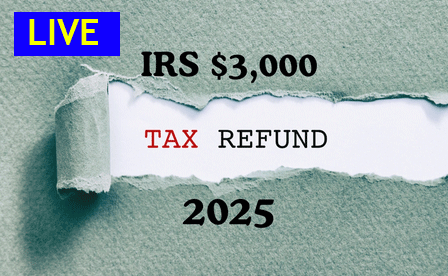IRS Data Reveals 2% Rise in Average Tax Refund Amount. Read Now
Average Tax Refund Amount Sees Slight Increase: What You Need to Know
The Internal Revenue Service (IRS) has released its latest tax season statistics, revealing a modest uptick in the average tax refund amount compared to mid-October 2024. According to the IRS data, more than 102 million Americans have received their tax refunds, with the average filer getting back approximately 1.6% more than they did last year. In this article, we’ll dive deeper into the latest tax refund statistics and explore what they mean for taxpayers.
Key Findings
The IRS data shows that the average tax refund amount stands at $3,052, representing a 1.6% increase from the same period last year. This translates to an additional $48 in refund amount for taxpayers who received an average refund last year. While the increase may seem modest, it’s essential to understand the factors contributing to this trend.
Total Refunds Issued
Despite a slight decline in the number of refunds issued, the IRS has distributed $311.6 billion worth of refunds, up 0.6% from the $309.9 billion issued in mid-October 2024. This increase in total refund amount is a positive sign for taxpayers who are eagerly awaiting their refunds.
Tax Returns Received
The IRS has received 163,594,000 tax returns, marking a 1.3% increase from the 161,489,000 received as of October 18, 2024. This increase in tax returns received suggests that taxpayers are filing their tax returns in a timely manner, which can help reduce the likelihood of errors and delays.
Breakdown of Tax Refund Statistics
Here’s a breakdown of the latest tax refund statistics:
- Number of Refunds Issued: 102,122,000 (down 1% from last year)
- Total Refund Amount: $311.6 billion (up 0.6% from last year)
- Average Direct Deposit Refund: $3,151 (up 1.9% from last year)
What Does This Mean for Taxpayers?
While the increase in average tax refund amount may provide some relief for taxpayers, it’s essential to understand the factors contributing to this trend. According to experts, the rise in average refund amount could be attributed to various factors, including changes in tax laws, inflation adjustments, and increased tax credits.
Factors Influencing Tax Refund Amounts
There are several factors that can influence tax refund amounts, including:
- Tax Law Changes: Changes in tax laws, such as adjustments to tax brackets and deductions, can impact refund amounts.
- Inflation Adjustments: Annual inflation adjustments to the standard deduction and tax brackets can also influence refund amounts.
- Tax Credits: Increased tax credits, such as the Earned Income Tax Credit (EITC) and Child Tax Credit, can lead to larger refunds for eligible taxpayers.
Impact on Taxpayers
The increase in average tax refund amount can have a positive impact on taxpayers who are struggling financially. A larger refund can provide a much-needed boost to help cover expenses, pay off debt, or build savings. However, it’s essential for taxpayers to understand that tax refunds are not a guaranteed entitlement and should not be relied upon as a source of income.
Tax Filing Season Statistics
The IRS has received over 163 million tax returns, with more than 102 million taxpayers receiving refunds. The IRS has also issued over $311 billion in refunds, with the average direct deposit refund amount standing at $3,151.
Conclusion
The latest tax refund statistics from the IRS reveal a modest increase in the average tax refund amount. While this may provide some relief for taxpayers, it’s essential to understand the factors contributing to this trend. Taxpayers should stay informed about tax laws, inflation adjustments, and tax credits to maximize their refund amounts. As the tax season continues, taxpayers can expect to receive their refunds within a few weeks of filing their tax returns. The IRS recommends e-filing and choosing direct deposit to receive refunds quickly.
Additional Resources
For more information on tax refunds and tax filing season statistics, taxpayers can visit the IRS website or consult with a tax professional. The IRS also offers resources and tools to help taxpayers navigate the tax filing process and maximize their refund amounts.
By staying informed and understanding the factors that influence tax refund amounts, taxpayers can make the most of their tax refunds and plan for their financial futures.
Tax Filing Tips: Maximizing Your Refund
As tax season approaches, it’s essential to be prepared and informed to maximize your refund. Here are some valuable tips to help you navigate the tax filing process:
1. Gather necessary documents: Ensure you have all required documents, including W-2s, 1099s, and receipts for deductions.
2. Understand tax credits: Familiarize yourself with tax credits like the Earned Income Tax Credit (EITC) and Child Tax Credit, which can significantly impact your refund.
3. Choose the right filing status: Select the filing status that benefits you most, such as single, married filing jointly, or head of household.
4. Take advantage of deductions: Claim deductions for mortgage interest, charitable donations, and medical expenses to reduce your taxable income.
5. Consider e-filing: E-filing is faster, more accurate, and can help you receive your refund quicker.
6. Check for errors: Double-check your return for errors and discrepancies to avoid delays or audits.
7. Keep records: Maintain accurate records of your income, expenses, and tax-related documents for future reference.
8. Consult a professional: If you’re unsure about any aspect of your tax return, consider consulting a tax professional for personalized guidance.
9. Stay informed: Stay up-to-date with tax law changes and updates to ensure you’re taking advantage of available credits and deductions.
10. File on time: File your tax return by the deadline to avoid penalties and interest on any tax owed.
By following these tips, you can maximize your refund and ensure a smooth tax filing experience.
Additional Tips:
- Use tax planning tools: Utilize tax planning tools and calculators to estimate your refund and identify potential deductions.
- Consider a tax professional: If you have complex tax situations or are unsure about specific tax laws, consider hiring a tax professional.
- Keep your personal and financial information secure: Protect your sensitive information when filing process to prevent identity theft.
Refund Tracking:
- Use the IRS’s “Where’s My Refund?” tool: Track the status of your refund online or through the IRS2Go app.
- Sign up for refund notifications: Receive updates on your refund status via email or text message.
By following these tips and staying informed, you can navigate the tax filing process with confidence and maximize your refund.







